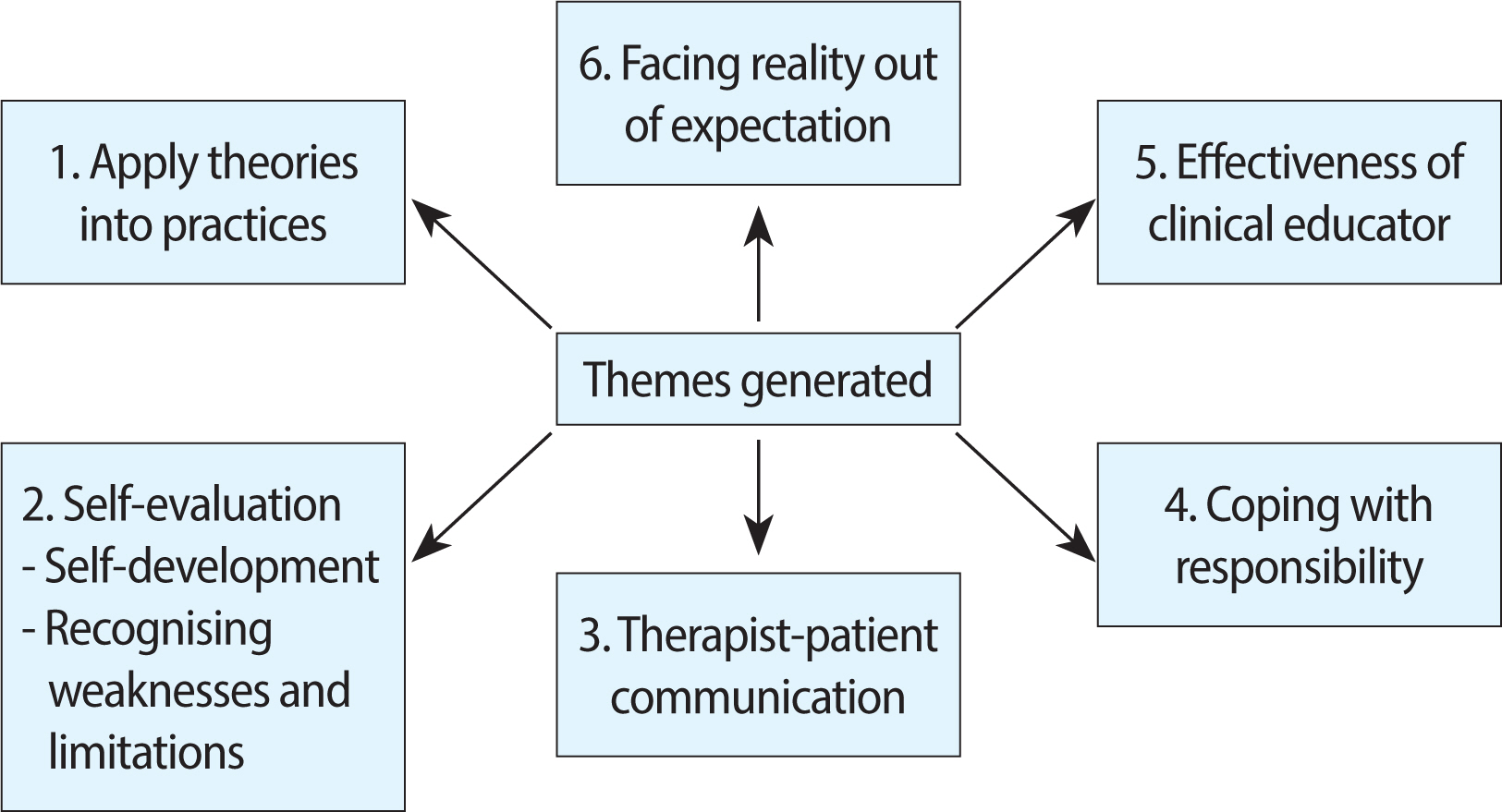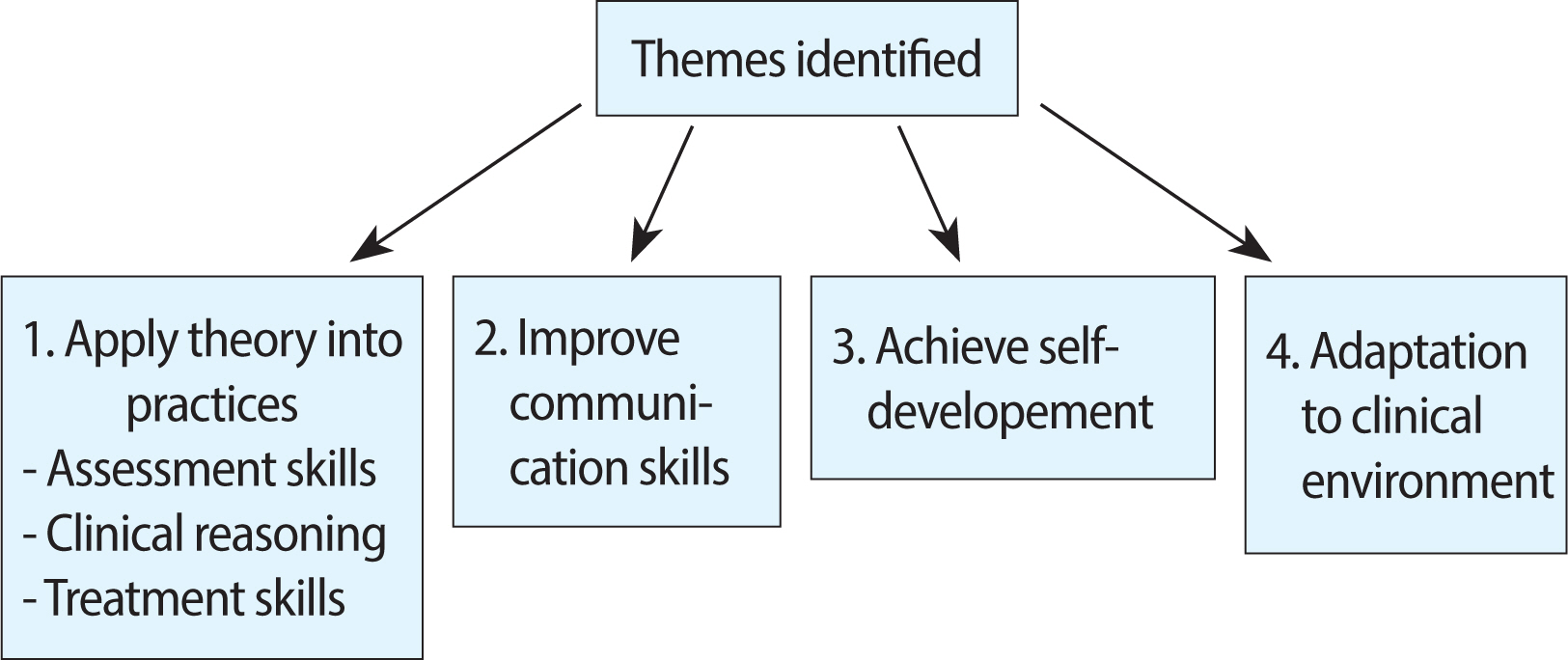J Educ Eval Health Prof.
2013;10:6.
Learning pathways during clinical placement of physiotherapy students: a Malaysian experience of using learning contracts and reflective diaries
- Affiliations
-
- 1Physiotherapy Programme, School of Rehabilitation Sciences, Faculty of Health Sciences, Universiti Kebangsaan Malaysia, Kuala Lumpur, Malaysia. kamalia086@gmail.com
Abstract
- PURPOSE
Learning contracts and reflective diaries are educational tools that have been recently introduced to physiotherapy students from Malaysia during clinical education. It is unclear how students perceive the experience of using a learning contract and reflective diary. This study explores the learning pathways of the students after using a learning contract and a reflective diary for the first time in their clinical placement.
METHODS
A total of 26 final-year physiotherapy students completed a learning contract and a reflective diary during clinical placements. Two researchers explored the data qualitatively by the thematic content analysis method using NVivo.
RESULTS
A total of four and six main learning themes were identified from the data of the students through a learning contract and reflective diary.
CONCLUSION
These learning themes reflected the views of the students about what they have considered to be important learning pathways during their clinical placements. They give valuable insights into the experiences and opinions of students during their clinical education process, which should be useful for enhancing teaching and learning methods in physiotherapy education.
Keyword
Figure
Reference
-
1. Mann K, Gordon J, MacLeod A. Reflection and reflective practice in health professions education: a systematic review. Adv Health Sci Educ Theory Pract. 2009; 14:595–621. http://dx.doi.org/10.1007/s10459-007-9090-2.
Article2. Ganesh A, Ganesh G. Reflective writing by final year medical students: lessons for curricular change. Natl Med J India. 2010; 23:226–230.3. White P. Using reflective practice in the physiotherapy curriculum. Tate S, Sills M, editors. The development of critical reflection in the health professions. London: Health Sciences and Practice Subject Centre;2004. p. 24–31.4. Lie D, Shapiro J, Cohn F, Najm W. Reflective practice enriches clerkship student’s cross-cultural experiences. J Gen Intern Med. 2010; 25:S119–S125. http://dx.doi.org/10.1007/s11606-009-1205-4.
Article5. Zimmerman SS, Hanson DJ, Stube JE, Jedlicka JS, Fox L. Using the power of student reflection to enhance professional development. Internet J Allied Health Sci Pract. 2007; 5.
Article6. Mohtashami J, Noughani F. Comparing efficacy of implementing two teaching methods contract learning and traditional instruction on clinical skills of nursing students in psychiatric wards of hospitals of Tehran. J Med Educ. 2007; 11:45–49.7. Cheek J, Jones J. What nurses say they do and need: implications for the educational preparation of nurses. Nurs Educ Today. 2003; 23:40–50. http://dx.doi.org/10.1016/S0260-6917(02)00163-6.
Article8. Burnard P. A method of analysing interview transcripts in qualitative research. Nurs Educ Today. 1991; 11:461–466.
Article9. Schilling J. On the pragmatics of qualitative assessment: designing the process of analysis. Eur J Psychol Assess. 2006; 22:28–37. http://dx.doi.org/10.1027/1015-5759.22.1.28.10. Rye KJ. Perceived benefits of the use of learning contracts to guide clinical education in respiratory care students. Respir Care. 2008; 53:1475–1481.11. Cooper C, Taft LB, Thelen M. Preparing for practice: students’ reflections on their final clinical experience. J Prof Nurs. 2005; 21:293–302. http://dx.doi.org/10.1016/j.profnurs.2005.07.002.
Article12. William R, MacDermid J, Wessel J. Student adaptation to problem-based learning in an entry-level master’s physical therapy program. Physiother Theory Pract. 2003; 19:199–212.13. Larin H, Wessel J, Al-Shamlan A. Reflections of physiotherapy students in the United Arab Emirates during their clinical placements: a qualitative study. BMC Med Educ. 2005; 5:3. http://dx.doi.org/10.1186/1472-6920-5-3.
Article14. Andrew M, Roberts D. Supporting student nurses learning in and through clinical practice: the role of the clinical guide. Nurse Educ Today. 2003; 23:474–481. http://dx.doi.org/10.1016/S0260-6917(03)00076-5.15. Wilkes Z. The student-mentor relationship: a review of the literature. Nurs Stand. 2006; 20:42–47.
Article
- Full Text Links
- Actions
-
Cited
- CITED
-
- Close
- Share
- Similar articles
-
- Perception about Problem-based Learning in Reflective Journals among Undergraduate Nursing Students
- An analysis of medical students’ reflective essays in problem-based learning
- A Study on the Use of Reflective Journals in Problem Based Learning
- Development and Implementation of a Learning Community in the Curriculum for Undergraduate Medical Students
- The Effect of Self-directed Learning Strategies on e-Learning Pre-learning of Nursing Students: Focusing on the Flow Experience



